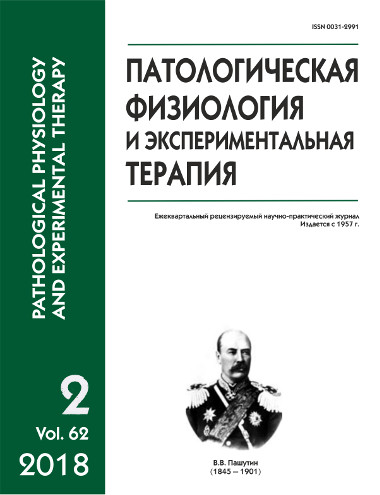Significance of the «youth protein», GDF11, and «aging proteins», CCL11, GDF15, and jam-a, for regulation of blood pressure in healthy and hypertensive women
Abstract
The aim of this work was to study the relationship between contents of GDF11, GDF15, CCL11, and JAM-A proteins and blood pressure in healthy women and women with essential hypertension. Methods. The study involved 118 women. Contents of GDF11, GDF15, JAM-A, and CCL11 were measured using the enzyme immunoassay (ELISA). Ratios of the "youth protein” to “aging proteins" (GDF11/GDF15, GDF11/CCL11, and GDF11/JAM-A) were computed. Systolic (SBP) and diastolic (DBP) blood pressure was measured using the Korotkov method. Results. In hypertensive women, the content of the "youth protein", GDF11, was significantly reduced, and concentrations of "aging proteins", GDF15, CCL-11, and the adhesion molecule JAM-A, were increased. Some "youth and aging proteins” were positively or negatively correlated with blood pressure. The greater was the ratio of the "youth protein", GDF11, to "aging proteins", GDF15, CCL-11, and JAM-A, the lower was systolic, diastolic, and mean blood pressure. Therefore, the relationship between the ratio of the "youth protein", GDF11, to "aging proteins", GDF15, CCL11, and JAM-A, plays a substantially greater role in regulation of blood pressure than each of these molecules alone. Conclusion. Systematic use of kinesiotherapeutic courses for 2-3 years restores a normal "youth to aging protein" ratio and improves blood pressure.
Downloads
References
2. Bitto A., Kaeberlein M. Rejuvenation: It’s in our blood. Cell metabolism. 2014; 20(1): 2-4.
3. Castellano J.M., Kirby E.D., Wyss-Coray T. Blood-Borne Revitalization of the Aged Brain. JAMA Neurol. 2015; 72(10): 1191-4.
4. Loffredo F.S., Steinhauser M.L., Jay S.M. et al. Growth Differentiation Factor 11 Is a Circulating Factor that Reverses Age-Related Cardiac Hypertrophy. Cell. 2013; 153(4): 828-39.
5. Olson K.A., Beatty A.L., Heidecker B. et al. Association of growth differentiation factor 11/8, putative anti-ageing factor, with cardiovascular outcomes and overall mortality in humans: analysis of the Heart and Soul and HUNT3 cohorts. Eur Heart J. 2015; 36(48): 3426-34.
6. Brown D.A., Breit S.N., Buring J. et al. Concentration in plasma of macrophage inhibitory cytokine-1 and risk of cardiovascular events in women: A nested case-control study. Lancet. 2002; 359: 2159-63.
7. Wiklund F.E., Bennet A.M., Magnusson P.K., et al. Macrophage inhibitory cytokine-1 (MIC-1/GDF15): a new marker of all-cause mortality. Aging Cell. 2010; 9(6): 1057-64.
8. Norozi K., Buchhorn R., Yasin A. et al. Growth differentiation factor 15: An additional diagnostic tool for the risk stratification of developing heart failure in patients with operated congenital heart defects. Am Heart J. 2011; 162(1): 131-5.
9. Dominguez-Rodriguez A., Abreu-Gonzalez P., Hernandez-Baldomero I.F. et al. Change in growth differentiation factor 15, but not C-reactive protein, independently predicts major cardiac events in patients with non-ST elevation acute coronary syndrome. Mediators of inflammation. 2014. Available at: https://www.hindawi.com/journals/mi/2014/929536 (Accessed 23 may 2017).
10. Ong K.L., Leung R.Y., Babinska A., Salifu M.O., Ehrlich Y.H, Kornecki E. et al. Elevated plasma level of soluble F11 receptor/junctional adhesion molecule-A (F11R/JAM-A) in hypertension. Am J Hypertens. 2009; 22(5): 500-5
11. R Core Team. R: A language and environment for statistical computing. R Foundation for Statistical Computing, Vienna, Austria. 2017; Available at: https://www.R-project.org (Accessed 23 may 2017).






